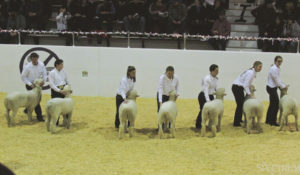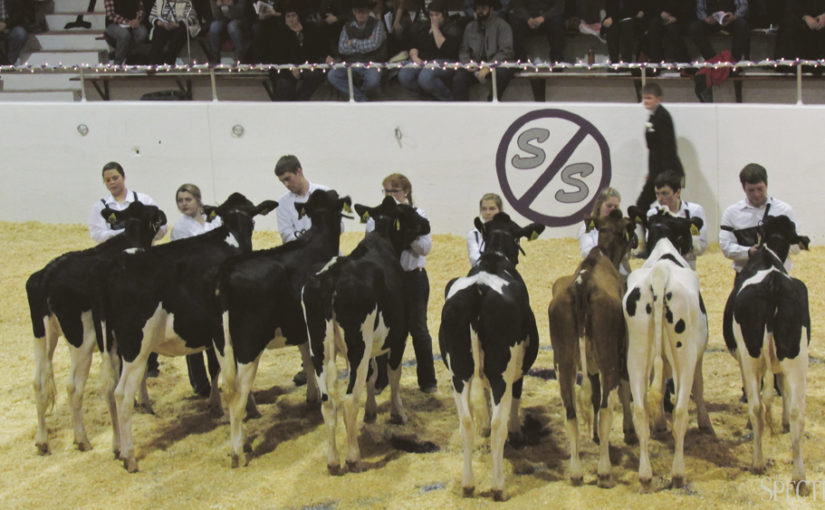The 92nd Little International, known as “Little I,” put on by the North Dakota State student organization Saddle & Sirloin, took place Feb. 10. Students show an animal they have worked with for the past two to four weeks in hopes of winning best showman of the event.
The event was started by the livestock team in 1918 who went to Chicago for a “Little I” livestock show, which led them to start an event just like it. So, they started the Little International with a show in 1922, where they focused on the showmanship side of the competition. The purpose was to promote animal husbandry and agriculture.

In the sheep division students work with their animal for only around 2.5 weeks before showing.
Many places have their own form of Little International, where they have the basics but add their own uniqueness to their competition.
This year’s Little I Queen was Emily Hauck, and her two princesses were Jessica Fleck and Brittney Aasand. Hauck, a junior majoring in agriculture communication, was able to speak on how the event went and what is was like being royalty of this year.
Hauck believes Little I, gives more than just a chance for people to show an animal, but also bringing awareness to the agriculture community. “Promoting agriculture and animal husbandry – I think that’s really what this club was kind of based on — and recognize people who are outstanding in agriculture,” Hauck said.
“I think they (the showmen) don’t always realize what they’re doing when they’re showing an animal, they get out there they work with their animal all the time and they think, ‘Oh I’m just out here having fun and making memories with people in my club,’ but they don’t realize that it is reaching so much more than that when we are promoting agriculture,” Hauck explained.
“Even if only like 150 people are participating within the show directly as showing an animal, there’s so many behind the scenes people that are kind of a part of a committee or that are just around helping out,” Hauk said.
There are two different showmanship events, one in the morning and the final at night. The morning shows the judges have around 15 minutes to look at how each person shows their animal. By the end of that show, they tend to have an idea of who did better than others. Then the night show is when they have seven minutes to look at each showman and finalize their scoring.
Different species are judged differently, but there are multiple areas where they are tested to see who a better showman is. Judges ask questions, critique how you move, control and present the animal and eye contact with the judge have parts to play with the scoring for categories.
There are many titles awarded for each category, and the overall champions are then taken into a “Round Robin” where they are assessed on how they can handle other species other than their own.
This year’s winners:
For Beef Division:
Garrett Becker for Champion Beef Showman and Hardest Worker
Jacob Frandrup for Reserve Champion Beef Showman
Sarah Labine for Top Novice Beef Showman
Dairy Division:

Students show off their dairy heifers they have been working with since January 7.
Jessie Dingmann for Champion Dairy Showman and Hardest Worker
Chris McRell for Reserve Champion Dairy Showman
Brittany Rademacher for Top Novice Dairy Showman
Sheep Division:
Ben Pearson for Champion Sheep Overall Showman and Hardest Worker
Katelyn Schmoll for Reserve Champion Overall Showman
Morgan Ziesch for Top Novice Overall Showman
Swine Division:
Klay Oland for Champion Overall Swine Showman and Hardest Worker
Miles Novak for Reserve Champion Overall Swine Showman
Katelyn Oland for Top Novice Overall Swine Showman
For the final results, the Grand Champion Overall Showman was Klay Oland, with Ben Pearson winning the Reserve Champion.
Oland is a senior majoring in animal science. He has shown at county fairs and showed the past three years for Little International. He has shown cattle and sheep in previous years, but this year he changed to swine.
Since Oland has only shown pigs two times at a county fair and state fair, he had a lot of advice from his friends who are good pig showmen. “The pig superintendent this year, who kind of oversees everybody who is showing pigs — he won last year pig showmanship, so he gave me a lot of advice too,” Oland explained.
Oland was worried when his pig went lame, forcing him to give her four days off. He explained that since they got the pigs at market weight and they are raised in confinement, they are not used to walking so much, leaving her to become lame after a while.
Although that was rough, he was able to pull her out of it. “This is honestly the most fun I’ve ever had, I just went out there and tried not to think too much, just had fun showing,” Oland said.
He explained that it still hasn’t sunken in that he was the grand champion for this year’s Little I competition. He explained that people constantly come up to him and message him, congratulating him on his victory.
Oland was speechless on his award and said, “It’s a pretty big honor.”
Hauk followed this by saying the event brings people together because so many people have been in Little I, so it brings a connection between people and creates “Decades of Tradition.”
